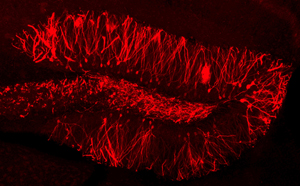Sep. 13, 2013 Research Highlight Biology
Making memories
Modifying the activity of neuronal networks that encode spatial memories leads to the formation of an incorrect fear memory in mice
 Figure 1: Channelrhodopsin-2 expression (red) in the dentate gyrus of the hippocampus. © 2013 AAAS
Figure 1: Channelrhodopsin-2 expression (red) in the dentate gyrus of the hippocampus. © 2013 AAAS
The formation and retrieval of memories allows all kinds of organisms, including humans, to learn and thrive in their environment. Yet our memories are not always accurate, and mistaken remembrances can have important consequences, such as in the justice system and in our navigation of the world. Susumu Tonegawa, Steve Ramirez, Xu Liu and colleagues at the RIKEN-MIT Center for Neural Circuit Genetics, have gained insight into the creation of mistaken memories by using light activation of neurons to generate an incorrect fear memory in mice1.
The researchers allowed mice to explore a novel location and used genetic techniques to label neurons in the hippocampus—a part of the brain linked to spatial memory—that were activated in the process with a special channel called channelrhodopsin-2 (Fig. 1). The cells that expressed this channel could then be artificially activated by light. In this way, the researchers were able to reactivate neurons that fired in that particular location, even if the mice were no longer there.
They then moved the mice to another location where they were exposed to foot shocks, causing the mice to exhibit immobility, a fear behavior. At the same time, the researchers used light to activate the channelrhodopsin-2-expressing neurons that had fired in the first location.
When Tonegawa and his colleagues moved the animals to a third location, they did not show fear behavior. Yet when the mice went back to the first location, where they had never experienced a foot shock, the mice now exhibited prominent freezing behavior. The researchers had generated a ‘false memory’ in the mice of foot shocks in a location in which they had never been exposed to them.
The researchers showed that light reactivation of neuronal networks in the central area of the hippocampus, called the dentate gyrus, could create false memories, while reactivation of the outer ‘CA1’ area of the hippocampus could not. Tonegawa and his colleagues suggest that this is because mouse exploration of different locations leads to activation of more overlapping neuronal networks in the CA1 than in the dentate gyrus. “This may reflect the fundamental differences of how memories are encoded in these two regions,” explains Liu.
The findings provide insight into how the brain encodes and processes memories and could one day lead to treatments for post-traumatic stress disorder. “Our work may also have implications for situations where patients mix reality with their own imaginations, such as in schizophrenia,” says Liu.
References
- 1. Ramirez, S., Liu, X., Lin, P.-A., Suh, J., Pignatelli, M., Redondo, R. L., Ryan, T. J. & Tonegawa, S. Creating a false memory in the hippocampus. Science 341, 387–391 (2013). doi: 10.1126/science.1239073
